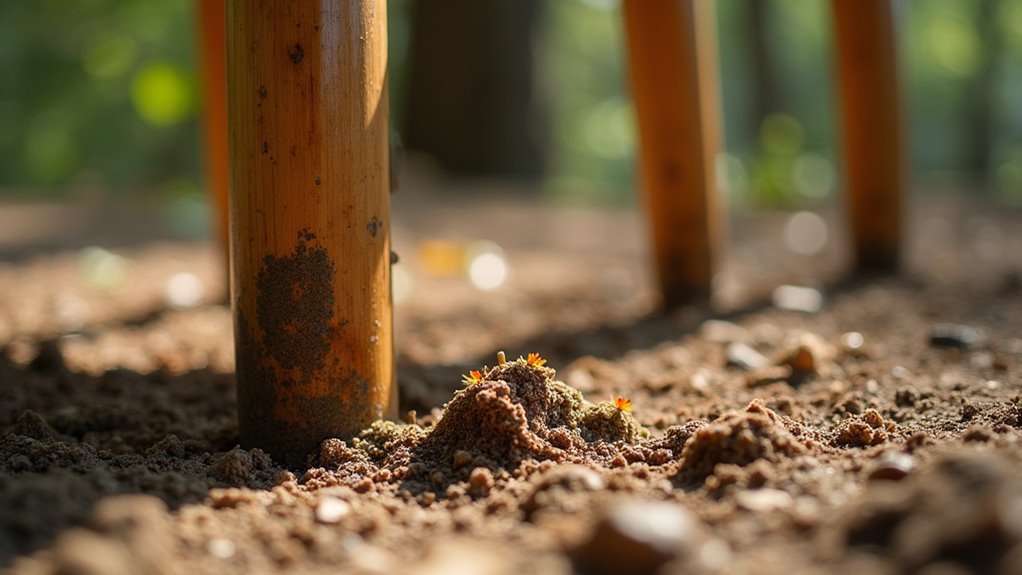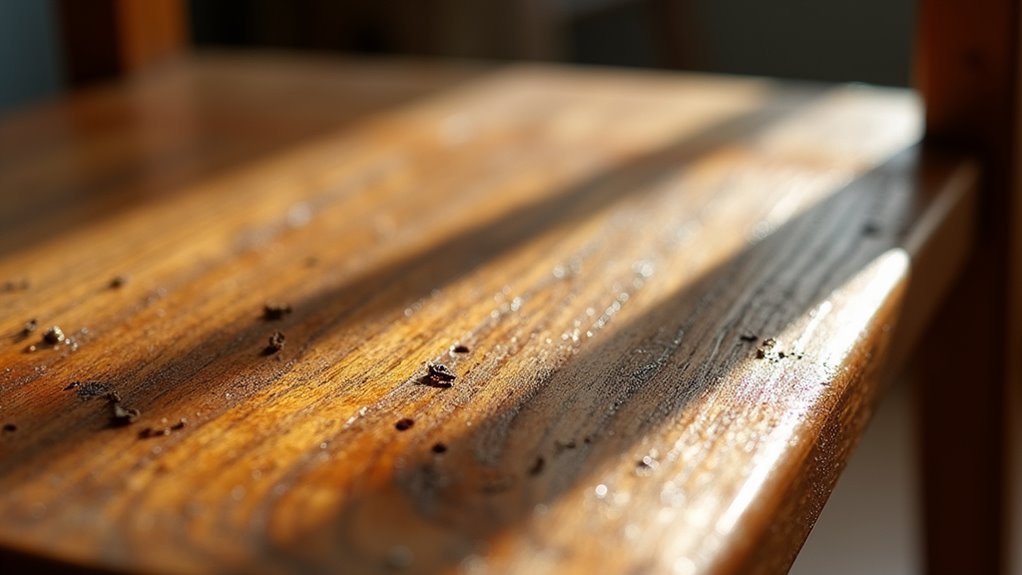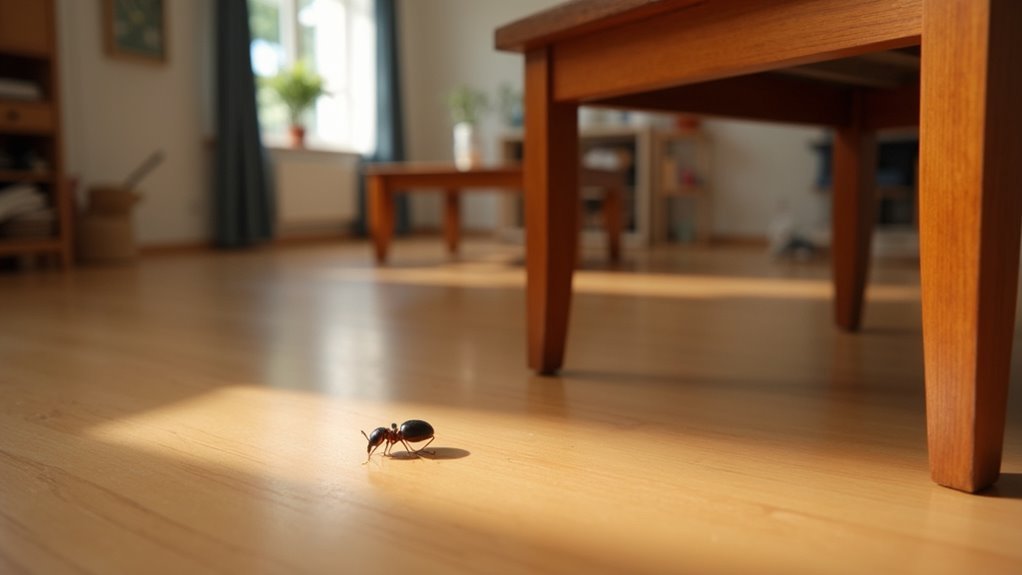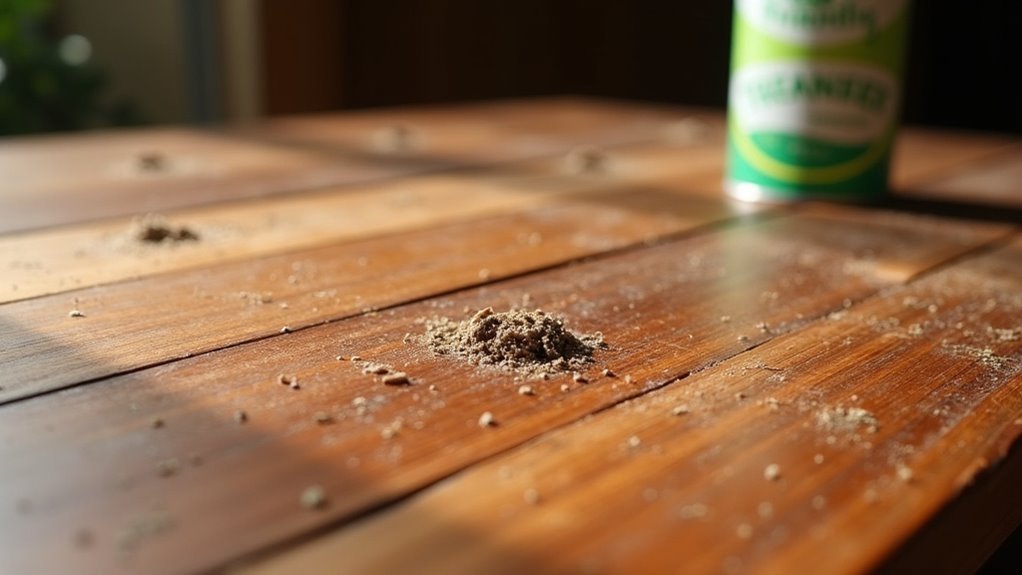Termites avoid treated furniture because chemical barriers like borate compounds and termiticides disrupt their nervous systems and make wood toxic to consume. You’ll find that moisture control through dehumidifiers and proper ventilation creates hostile environments since termites require high humidity to survive. Natural repellents like neem oil, orange oil, and essential oil sprays create protective barriers that termites find unpalatable. Regular maintenance with termite-resistant polishes and waterproof treatments further enhances protection by eliminating the moisture and accessibility that attracts colonies to explore advanced prevention strategies.
Chemical Barriers That Repel Termite Colonies

When protecting your furniture from termite damage, chemical barriers offer one of the most effective defense strategies available. These specialized treatments create protective layers that termite colonies find unpalatable, effectively preventing infestations before they start.
Borate-based products excel at forming long-lasting barriers on wooden surfaces. When you apply these treatments, they penetrate deep into the wood fibers, making your furniture toxic to termites upon contact or ingestion.
Borate treatments penetrate wood fibers deeply, creating toxic barriers that eliminate termites on contact while providing long-lasting furniture protection.
Termiticides containing active ingredients like fipronil or imidacloprid disrupt termites’ nervous systems, creating inhospitable environments around treated areas.
These chemical barriers can protect your furniture for several years when applied correctly. You’ll need to reapply treatments periodically to maintain effectiveness, especially in high-risk areas where termite infestations commonly occur.
Moisture Control Methods That Deter Termite Activity
You can greatly reduce termite threats by controlling moisture levels in your home through strategic dehumidification and ventilation improvements.
Dehumidifiers work effectively to maintain ideal humidity levels that make your space less attractive to termite colonies seeking moist environments for survival.
Proper ventilation systems eliminate trapped moisture in crawl spaces, basements, and other areas where termites typically establish their colonies.
Dehumidification Prevents Termite Colonization
Since termites require moisture to survive and establish colonies, controlling humidity levels in your home becomes one of your most effective defenses against infestation.
Dehumidification creates an environment where these pests can’t thrive, effectively helping you prevent termites from targeting your wooden furniture.
You can implement several moisture control strategies:
- Install air conditioners and dehumidifiers to maintain ideal indoor humidity levels
- Inspect plumbing regularly for leaks and repair issues immediately
- Guarantee proper crawl space ventilation with vapor barriers installed
Keep your wooden furniture elevated off the ground and away from damp soil contact.
This prevents direct moisture exposure that attracts termites.
Well-ventilated spaces with controlled humidity make it nearly impossible for termite colonies to establish themselves, protecting your valuable furniture investments long-term.
Proper Ventilation Eliminates Moisture
Effective ventilation systems create powerful barriers against termite infestations by eliminating the moisture-rich environments these pests need to survive.
You’ll want to install exhaust fans in moisture-prone areas like kitchens and bathrooms, where humidity naturally accumulates. These fans greatly reduce moisture levels that attract termite activity.
Regular window opening and strategic dehumidifier placement enhance airflow throughout damp spaces, creating conditions that prevent termites from establishing colonies.
You should seal gaps around windows, doors, and vents to stop moisture accumulation that encourages infestations.
Don’t overlook your crawl space – maintaining proper ventilation there with vapor barriers dramatically lowers moisture levels.
This combination of ventilation strategies makes your home’s environment hostile to termites, protecting your furniture from potential damage while maintaining healthier indoor air quality.
Wood Treatment Compounds That Create Hostile Environments

When termites encounter wood treated with hostile compounds, they face an environment designed to repel and deter their presence. Wood treatment compounds containing borate create toxic conditions that effectively prevent infestations by making treated surfaces uninhabitable for these destructive pests.
You’ll find several effective treatment options that create barriers against termite invasion:
- Termite-resistant wood polishes – Oil-based varnishes form protective barriers while enhancing appearance
- Natural oils – Orange oil and neem oil disrupt termite hormones and feeding patterns
- Waterproof paints – Eliminate moisture that attracts termites to wooden furniture
Regular application of treatments containing essential oils maintains a hostile environment over time.
These compounds work by disrupting termite biology, creating chemical barriers, and removing environmental factors that encourage infestations, ensuring your furniture remains protected.
Natural Oil Applications That Block Termite Access
Among the most accessible and environmentally friendly approaches, natural oils offer powerful protection against termite intrusion.
You can protect your wooden furniture using neem oil, orange oil, and clove oil, which contain compounds that disrupt termite pheromones and effectively repel these destructive pests.
A simple mixture of four parts olive oil with one part white vinegar creates a protective barrier when applied regularly.
Essential oils like tea tree and rosemary work excellently in diluted sprays, maintaining indoor air quality while preventing termite infestation.
Aloe vera gel serves as another natural barrier, making wooden surfaces less attractive to termites.
These natural oils enhance your furniture’s longevity by creating hostile environments that minimize potential damage.
Regular Maintenance Practices That Prevent Infestations

Consistency marks the difference between furniture that lasts decades and pieces that fall victim to termite damage within years. Inspecting your wooden furniture regularly helps you spot early warning signs like cracks or wear patterns before termites establish colonies.
You’ll keep termites at bay by maintaining a strict schedule that addresses multiple vulnerability points.
Essential maintenance practices include:
- Moisture control: Clean with dry microfiber cloths instead of liquid cleaners to prevent dampness accumulation
- Protective treatments: Apply termite-resistant polish every six months to create defensive barriers
- Environmental management: Guarantee proper ventilation in storage areas and fix plumbing leaks immediately
Refurbishing pieces with beeswax or wood oil strengthens the material while restoring appearance.
These proactive steps transform your furniture into termite-resistant investments rather than potential infestations waiting to happen.
Protective Coatings That Form Impenetrable Shields
While regular maintenance forms your first line of defense, protective coatings create the ultimate barrier that termites simply can’t breach.
These specialized treatments work by forming a hard, glossy surface that prevents termite penetration into the underlying wood. When you apply termite-resistant wood polish, you’re creating a chemical barrier that actively repels these destructive pests, making it nearly impossible for them to establish colonies in your furniture.
You’ll enhance this protection by applying waterproof paint annually, which serves a dual purpose: reducing moisture levels that attract termites while shielding wood from environmental exposure.
Oil-based varnishes add another defensive layer, as termites avoid these coated surfaces. Regular refurbishment guarantees your protective barrier remains intact and potent against future termite threats.
Environmental Factors That Make Furniture Uninhabitable
Beyond surface treatments, you can transform your home’s environment into a hostile territory for termites by controlling the conditions that draw them to your furniture in the first place.
Effective pest control starts with understanding that termites crave moisture-rich environments. When you maintain low humidity levels and guarantee proper ventilation throughout your home, you’ll prevent termites from finding the damp conditions they need to survive.
Controlling moisture and humidity levels in your home creates an environment where termites simply cannot thrive or establish colonies.
Strategic furniture placement becomes essential for long-term protection:
- Keep wooden furniture away from damp basements, bathrooms, and laundry areas
- Guarantee all furniture pieces remain elevated and never touch soil directly
- Position items away from water sources like pipes, windows, and exterior walls
These environmental modifications create an inhospitable atmosphere that forces termites to seek more favorable locations elsewhere.
Professional Treatment Solutions That Eliminate Termite Threats
When your environmental controls aren’t enough to stop an existing infestation, professional treatment solutions offer the decisive action needed to eliminate termite threats from your furniture.
You’ll find that fumigation provides extensive eradication by penetrating all wood surfaces, guaranteeing no drywood termites survive. For targeted approaches, exterminators can apply localized spot treatments using specialized insecticides, minimizing chemical exposure throughout your home.
Professional treatments begin with thorough inspections using advanced technology like thermal imaging to detect hidden colonies.
You’ll benefit from eco-friendly options such as borate-based solutions that effectively combat termite infestations while protecting your family’s health.
These expert services guarantee timely intervention before significant damage occurs, giving you complete peace of mind against future termite threats.
Physical Modifications That Reduce Termite Attraction
You can make your wooden furniture less appealing to termites through strategic physical modifications that target their ability to access and thrive on surfaces.
Surface texture modifications involve sanding rough areas smooth and applying protective coatings that create barriers termites can’t easily penetrate.
Moisture barrier applications help you seal your furniture against humidity and water damage, eliminating the damp conditions these pests need to survive.
Surface Texture Modifications
Since termites rely on their ability to grip and penetrate wood surfaces, modifying your furniture’s texture can serve as an effective physical deterrent.
You’ll want to focus on creating smooth, hard surfaces that make it difficult for termites to establish a foothold and chew through the material.
Applying glossy finishes creates a protective barrier that reduces moisture absorption while making the surface less accessible to termites.
Here’s what you should prioritize:
- Use termite-resistant coatings or varnishes that create smooth, non-porous surfaces
- Apply multiple layers of glossy finish to enhance surface hardness
- Avoid textured finishes that retain moisture and provide grip points
These surface texture modifications work by eliminating the conditions termites need to thrive while creating physical barriers that discourage infestations.
Moisture Barrier Applications
Moisture barriers take surface protection one step further by targeting the root cause of termite attraction: excessive humidity and dampness in wooden furniture.
You can install plastic sheeting or vapor barriers to prevent moisture accumulation, making your furniture less appealing to termites that thrive in damp conditions.
Seal gaps and cracks with appropriate sealants to block moisture ingress while maintaining dry interiors.
Elevate your wooden pieces off the ground to minimize contact with moisture sources, as termites won’t infest items sitting on damp surfaces.
These moisture barrier applications effectively prevent termites from infesting your valuable pieces while keeping your home protected.
Combine these techniques with proper ventilation to maintain low humidity levels and create unfavorable conditions for termite activity.
Preventive Measures That Stop Termites Before They Start
Although termite infestations can devastate wooden furniture, you can protect your investment by implementing simple preventive measures before these destructive pests arrive.
To prevent termites from targeting your furniture, you must create an environment they can’t tolerate. The most effective way to eliminate termite attraction starts with controlling moisture. Keep termites away by positioning furniture in dry, well-ventilated spaces where humidity can’t accumulate.
Termites thrive in humid conditions, so maintaining dry, well-ventilated spaces around your wooden furniture creates an inhospitable environment for these destructive pests.
Essential preventive strategies include:
- Apply termite-resistant wood polish regularly to create protective barriers
- Inspect wooden furniture frequently for cracks and repair damage immediately
- Use natural remedies like olive oil and white vinegar mixtures on surfaces
Schedule professional pest control inspections consistently to identify threats early.
These proactive measures keep termites away before they establish colonies, ensuring your furniture remains protected and your investment stays secure.
Frequently Asked Questions
Can You Treat a Piece of Furniture for Termites?
You can treat furniture for termites using insecticides, borax, or termite-resistant polish. DIY kits work for small infestations, while professionals handle extensive damage through fumigation treatments.
Does Termite Fumigation Damage Furniture?
Termite fumigation won’t damage most furniture since gaseous pesticides don’t harm wood directly. However, you’ll need special care for delicate antiques or pieces with intricate finishes to prevent potential damage.
How Do You Termite Proof Furniture?
You’ll termite-proof furniture by applying resistant wood polish, using olive oil-vinegar mixtures regularly, keeping pieces dry in ventilated areas, incorporating neem or orange oils, and maintaining regular refurbishment with proper sealing treatments.
Which Chemical Is Used for Coating Furniture to Prevent Termites?
You’ll commonly use borate compounds for coating furniture to prevent termites. These chemicals effectively repel termites and create a protective barrier. You can also apply oil-based varnishes or specialized insect-repelling wood polishes for additional protection.
In Summary
You’ll protect your furniture by implementing these termite deterrent strategies consistently. Don’t rely on just one method—combine chemical barriers with moisture control and natural oils for maximum effectiveness. You’re creating an environment termites can’t survive in when you maintain proper treatments and make strategic physical modifications. Stay proactive with regular inspections and professional treatments. You’ve got the tools to keep termites away permanently if you’re committed to ongoing prevention efforts.





Leave a Reply